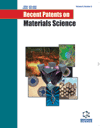-
s The Influence of Ammonia Addition on the Surface Characteristics of Fe3O4/Carbon Nanoparticles in Submerged Arc Discharge
- Source: Recent Patents on Materials Science, Volume 11, Issue 2, Oct 2018, p. 71 - 82
-
- 01 Oct 2018
Abstract
Background: Fe3O4/Carbon nanoparticles have attracted attention in a wide variety of applications. To make them more biocompatible, surface modification is required. A submerged arc discharge as a common technique has been reported in recent patents and research articles for carbonbased nanomaterials synthesis and possibly applied for those material modifications at once. However, the influence of liquid medium used on the materials surface properties has not been disclosed in detail in recent literature and patents. Objective: Therefore, this study aims to analyze the influence of ammonia addition on the surface characteristics of the Fe3O4/C particles produced in a submerged arc discharge using various ammonia concentrations. Method: The intended nanoparticles were produced and modified in a single process by submerged arc discharge in a liquid medium of ethanol added with ammonia. Applying a direct current (DC) of 10A (20V), the arc discharge occurred in a narrow gap between a carbon anode and carbon-mixed iron oxide cathode. During the arc discharge, active plasma species including ions, electrons, and radicals containing atoms available in the liquid medium were created in the plasma zone, and further interacted within to become an amine-modified Fe3O4/C composite. The surface characteristics were studied by Fouriertransform infrared (FTIR) spectrometer and scanning electron microscopy with energy dispersive X-ray (SEM-EDX) spectrometer. Results and Conclusion: The spectra generated by FTIR of Fe3O4/C showed a broad peak at a wavenumber of 4000-3000 cm-1 representing O-H and N-H intramolecular hydrogen bonding. Moreover, new peaks were observable for C-N stretching and N-H bending, neither of which was observed in the FTIR spectrum of Fe3O4/C without added ammonia. According to electron imaging, the nanoparticles formed regular spherical aggregations. In addition, EDX results confirmed that the nanoparticles produced in the arc discharge with ammonia addition process had an atomic percentage composition wherein the number of nitrogen atoms increased with an increasing concentration of ammonia. Nitrogen was absent in the synthesized nanoparticle solids without added ammonia, indicating that the nitrogen presumably comes from the amine groups. However, increasing the ammonia concentration led to the amine groups transforming into the other groups such as amides and nitroaromatic compounds due to the excessive oxidation.


